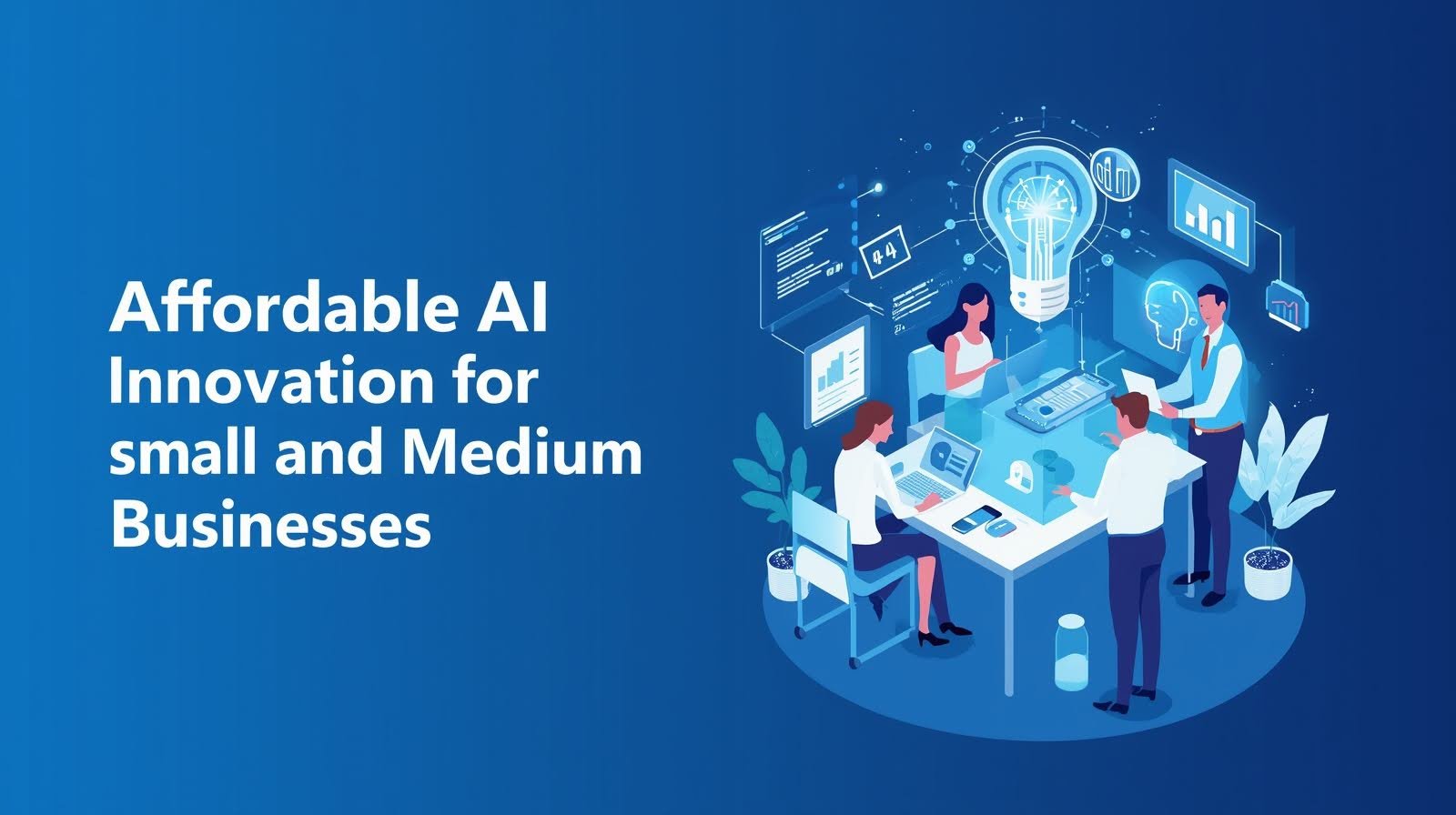Technology
AI on a Budget: Rethinking Innovation for Small and Medium Enterprises
Published
1 month agoon
By
Sky Bloom IT
Artificial Intelligence (AI) is no longer an experimental concept reserved for global tech giants. In 2025, it has become a practical, results-driven tool that even small and medium enterprises (SMEs) can use to compete, automate, and innovate. Whether it’s predictive analytics, intelligent customer support, or process optimization, AI is redefining how smaller businesses operate and scale.
Yet, despite its growing accessibility, one concern still looms large cost. Many SME owners still associate AI with massive budgets, proprietary software, and teams of data scientists. The reality, however, is changing fast. Advances in open-source technologies, cloud-based platforms, and affordable development services have made it possible to integrate AI capabilities without breaking the bank.
For SMEs, this shift represents a powerful opportunity: to innovate smarter, not spend harder. The key lies in rethinking what AI development really means focusing on lean, outcome-driven solutions rather than large-scale R&D projects.
Why Traditional AI Development Was Expensive
Not long ago, the idea of AI adoption for smaller enterprises was practically out of reach. Early AI development came with a long list of barriers like high infrastructure costs, scarce expertise, and complex implementation processes that often required entire data science teams to manage.
First, the hardware and infrastructure demands were steep. Training machine learning models required high-performance computing power, vast data storage, and specialized maintenance all of which added up quickly. For an SME, even setting up a modest AI environment could consume a significant portion of its annual technology budget.
Second, the talent gap made matters worse. Hiring experienced data scientists, AI engineers, and machine learning specialists was (and still is) costly. Many small businesses couldn’t justify the expense when their use cases were limited to a few automation tasks or simple analytics.
Lastly, proprietary AI platforms used to dominate the landscape. Licensing fees and vendor lock-ins made customization difficult and drove costs higher, discouraging smaller organizations from experimenting or scaling.
Fortunately, that landscape has evolved. In recent years, open-source frameworks, cloud services, and low-code AI tools have disrupted traditional models, reducing both technical complexity and financial barriers.
Democratization of AI: The 2025 Shift
The AI landscape in 2025 looks very different from just a few years ago. What was once a domain dominated by large enterprises with deep pockets has now opened up to smaller players. The democratization of AI is real and it’s being driven by several powerful forces reshaping how innovation happens.
A) Open-Source AI Frameworks
Open-source tools have been the great equalizer in AI development. Frameworks such as PyTorch, TensorFlow, and Hugging Face Transformers have made it easier for developers to access pre-trained models, reusable components, and community-driven improvements. SMEs no longer need to build from scratch they can adapt existing architectures and focus their budgets on fine-tuning and implementation.
B) Cloud-Based AI Services
Cloud computing has revolutionized the economics of AI. Platforms like AWS Bedrock, Google Vertex AI, and Azure AI Studio allow businesses to run AI workloads without owning expensive infrastructure. Pay-as-you-go models mean SMEs can start small, experiment, and scale as results improve. This flexibility has turned AI from a capital expense into an operational one — a key advantage for growing companies.
C) Low-Code and No-Code Platforms
AI-powered tools such as DataRobot, RapidMiner, and Runway ML are enabling non-technical teams to build models through simple drag-and-drop interfaces. For SMEs, this means marketing or operations staff can automate routine tasks, generate insights, and even prototype AI solutions without extensive coding knowledge.
In short, accessibility has become the new innovation driver. The result is a more level playing field one where small and medium enterprises can adopt AI not as a luxury, but as a strategic necessity.
Practical Strategies for Cost-Effective AI Development
While the ecosystem has become more accessible, affordability still depends on execution. Building an effective AI roadmap requires clarity, focus, and smart resource allocation. Below are practical strategies SMEs can apply to maximize AI’s potential while minimizing costs.
A) Start Small and Scale Gradually
Begin with a specific, measurable goal such as automating customer inquiries or predicting stock shortages. Pilot projects help validate results and prevent overspending on untested ideas. Once the initial project demonstrates value, scale it across departments or business units.
B) Leverage Open-Source AI Tools
Open-source models and libraries provide a head start without licensing costs. Instead of investing in proprietary software, SMEs can customize proven frameworks to suit their needs. This not only saves money but also fosters flexibility and innovation.
C) Adopt Cloud-Based AI Solutions
Cloud providers have eliminated the need for expensive on-premise hardware. Pay-as-you-go pricing allows businesses to deploy AI models, run analytics, or host chatbots at a fraction of traditional costs. Plus, cloud tools often come with built-in scalability and security critical for SMEs managing limited resources.
D) Partner with Affordable AI Development Provider
For many SMEs, in-house AI expertise is still limited. Collaborating with specialized AI development service provider can close that gap without the overhead of hiring full-time data scientists. These partners help identify the right use cases, implement cost-efficient solutions, and maintain models as the business grows all while ensuring projects stay within budget.
E) Upskill Your Existing Team
AI doesn’t have to replace your workforce it can enhance it. Training existing employees in data literacy, automation tools, and basic AI concepts can significantly reduce dependency on external consultants. Many platforms now offer free or low-cost AI courses tailored to business users, making continuous learning an affordable strategy.
Measuring ROI and Sustaining Innovation
Implementing AI is only the beginning. To ensure that innovation remains sustainable, SMEs must focus on measuring success, refining systems, and reinvesting wisely.
Track the Right Metrics
Start by defining clear performance indicators before launching any AI initiative. Common KPIs include:
- Cost savings from automation
- Reduction in manual work hours
- Increase in lead conversion or customer retention
- Downtime reduction in operations
Tracking these metrics helps demonstrate tangible value, making it easier to justify further investment in AI initiatives.
Iterate and Improve
AI is not a one-time project it’s an ongoing process. Models need retraining, systems require fine-tuning, and data pipelines evolve as businesses grow. Regularly reviewing performance ensures that solutions remain relevant and cost-effective over time.
Reinvest in Scalable Innovation
Once AI projects begin delivering measurable ROI, SMEs can strategically reinvest those savings into new AI-driven initiatives from predictive analytics to workflow automation. This creates a sustainable innovation loop: small wins fund bigger advancements, turning AI into a growth catalyst rather than a financial burden.
Future of SME AI Development: Efficiency Over Excess
As AI continues to evolve, one thing is clear: efficiency, not extravagance, will define the next phase of innovation. The tools emerging in 2025 from smaller, more efficient language models to pre-trained APIs and plug-and-play AI components are designed with accessibility in mind.
For SMEs, this trend is transformative. The future of AI development lies in modularity and adaptability being able to implement solutions that scale with business growth. Instead of pursuing massive, multi-year AI projects, smaller businesses can now build incrementally:
- Deploy lightweight chatbots to enhance customer service.
- Use predictive analytics to improve inventory and sales planning.
- Experiment with generative AI to create personalized marketing content.
This modular approach minimizes financial risk while accelerating innovation. It also allows SMEs to remain flexible adopting new tools as technology evolves, without overcommitting to a single system or platform.
Conclusion
For years, AI was seen as a privilege of scale a powerful but expensive advantage for enterprises with vast resources. That era is over. Today, artificial intelligence is a practical, scalable, and affordable tool that small and medium enterprises can use to compete, innovate, and grow.
What matters most isn’t how much a business spends on AI, but how strategically it applies it. By embracing open-source tools, leveraging cloud platforms, and collaborating with experienced AI development services, SMEs can unlock real value without exceeding their budgets.
The new era of AI isn’t about who spends more it’s about who innovates smarter. And for SMEs ready to think differently, the opportunity to lead has never been more within reach.
You may like


Why Did Apple Pull Advanced Data Protection in the UK: What’s Actually Going On?

Study Smarter: How Next-Generation Online Education Delivers Real-World Results

Top 5 Market Research Firms in the UK

The Impact of AI on Modern Financial Decision-Making

How Students Can Stay Connected During Study Abroad and Gap Year Adventures

Bridging the Gap Between Innovation and Real-World Project Delivery

Silent Engines of Industry: The Lifeblood Behind Every Machine

Upgrade Your Bedroom with Custom Wardrobes Made for You

A Winter Market Snapshot: Sittingbourne Buyer Demand and Pricing Trends

Graffitifun graffiti workshops: creative teambuilding and outings redefined

Carol Kirkwood’s Journey: Her Real Age, Husband, Career, and More

Revolutionizing Healthcare: The Emergence of AI-Driven Analytics

How Machine Learning and AI are Redefining the Future?

Aliza Barber: Meet Lance Barber’s Wife, Age, Life, Profile, Career and Net Worth

Evelyn Melendez: Jordan Knight’s Wife Bio, Marriage, Family, Career and Net Worth

Ilan Tobianah Biography: Family, Marriage, Lifestyle, Career and Net Worth

Who was Alice Marrow? Everything to Know About Ice-T’s and His Mother

King Von’s Autopsy Report: The Truth Behind the Tragic Death

Meet Otelia Cox: The Supportive Wife of Tony Cox – A True Fairy Tale Romance

Tea Leoni and Tim Daly Split – A Closer Look at Their Relationship and Breakup

Why Did Apple Pull Advanced Data Protection in the UK: What’s Actually Going On?

Study Smarter: How Next-Generation Online Education Delivers Real-World Results

Top 5 Market Research Firms in the UK

The Impact of AI on Modern Financial Decision-Making

How Students Can Stay Connected During Study Abroad and Gap Year Adventures

Bridging the Gap Between Innovation and Real-World Project Delivery

Silent Engines of Industry: The Lifeblood Behind Every Machine

Upgrade Your Bedroom with Custom Wardrobes Made for You

A Winter Market Snapshot: Sittingbourne Buyer Demand and Pricing Trends

Graffitifun graffiti workshops: creative teambuilding and outings redefined
Category
Trending
-

 News3 months ago
News3 months agoCarol Kirkwood’s Journey: Her Real Age, Husband, Career, and More
-

 Health2 years ago
Health2 years agoRevolutionizing Healthcare: The Emergence of AI-Driven Analytics
-

 Technology2 years ago
Technology2 years agoHow Machine Learning and AI are Redefining the Future?
-

 Celebrity2 years ago
Celebrity2 years agoAliza Barber: Meet Lance Barber’s Wife, Age, Life, Profile, Career and Net Worth
